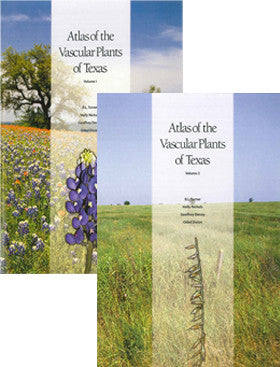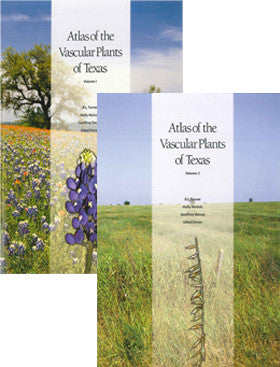The BRIT Store
Atlas of the Vascular Plants of Texas
Atlas of the Vascular Plants of Texas
Couldn't load pickup availability
Authors:
Billie Turner, Holly Nichols, Geoffrey C. Denny, and Oded Doron
SBM 24
ISSN 0883-1475
Volume 1 - Dicots
ISBN-13: 978-1-889878-08-9
Volume 2 - Ferns, Gymnosperms, Monocots
ISBN-13: 978-1-889878-09-6
Publication Date: 25 April 2003
Copyright © 2003 Botanical Research Institute of Texas
Specifications: 7.5"×10.5" (pbk); Vol. 1: 648 pp., Vol. 2: 240 pp., maps
About the Book
The Atlas of the Vascular Plants of Texas provides county-level dot maps for about 6000 taxa of vascular plants native and naturalized in Texas. Some taxa reported for Texas may not be accounted for in the Atlas, when vouchered material of such collections has not been personally studied. Within each of four major categories (ferns, gymnosperms, monocots, and dicots), the taxa are arranged alphabetically. If a species is deemed to have well-defined infraspecific categories in Texas, such are mapped. Distribution records for the Atlas are based primarily on herbarium vouchers from herbaria at the University of Texas-Austin (TEX-LL) and Sul Ross State University (SRSC), where all identifications have been personally verified by the first author. Other records have been taken from published literature from various sources and web-posted records from the “Texas flora” site (Texas A&M). Maps for the family Cactaceae were largely accounted for by A.M. Powell (Sul Ross State University-Alpine). All other distribution records have been manually recorded by Turner. Manually prepared maps were translated into electronic format by the three junior authors. If two or more independent collections were available from a given county, multiple symbols are placed in that county, but only rarely more than five to ten per county, depending upon its size, providing a broad picture of the more heavily collected portions of the state as well as insight into the regions of the state where the species concerned is most likely to be observed. A list of adventives is included at the end of each volume An introduction, index, and maps of Texas counties, floristic regions, and vegetational regions provide additional clarification and assistance in using the Atlas. Thirty-seven new nomenclatural combinations at specific and infraspecific rank are made in Acanthaceae, Apiaceae, Asteraceae, Brassicaceae, Caprifoliaceae, Euphorbiaceae, Fabaceae, Garryaceae, Nyctaginaceae, Onagraceae, Polemoniaceae, Portulacaceae, Rubiaceae, Sapotaceae, and Viscaceae.


